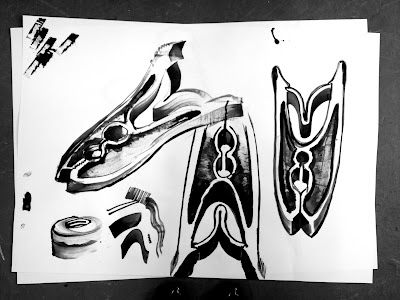3D Design Exploratory Stage
Beginning 3D Design, we looked firstly at design in the modern world and its progression - the design we now take for granted and where it stemmed from; the Bauhaus movement being a major source of inspiration that introduced functionalism, cubism and futurism into design. Contemporary design has now begun to move away from the harshness of the Modern movement and has become much more organic, focusing on combining style and ergonomics. We looked at the evolution of the telephone as an example, how the technologies available at the time influenced the design and so more recently the rate of change has increased rapidly.
As an exercise we began by taking objects and describing them with only line, no tone or shading. I found working on a large scale with graphite made it easier to loosen up and make strong, confident lines but found proportion quite difficult to get accurate. To improve I used a pencil as a guide to create parallel lines and angles, which would improve the communication of 3D form.
 |
| FIRST LINE DRAWING |
 |
| SECOND LINE DRAWING |
The next exercise was more experimental - using a piece of card and ink to draw objects, I found it very difficult to handle this way of drawing, I had to experiment with lots of different ways of mark making to try to convey the shape of the item as accurately as possible.
 |
| Progressing from left to right to centre drawing. |
We used our ink drawings to generate ideas by picking out sections or details and using card to replicate them in 3D, I experimented with scoring and folding, twisting, scrunching, cutting and stitching to see how I could make elements of the object that could then be used in the design of something else.
The Bauhaus
The Bauhaus was a school founded by Walter Gropius in Weimar, Germany 1919. It was famous for its combination of fine art and craft, they founded the idea of bringing all the arts together including architecture to create a ‘total’ work of art. The Bauhaus movement significantly influenced modernist architecture and modern design, and subsequent developments such as art, architecture, graphic design, interior design, industrial design, and typography. It’s style is characterized by the lack of ornamentation and the link between FORM and FUNCTION. The Bauhaus movement played a significant role in spreading geometric abstraction across the world even after its close in 1933.
 |
| The Bauhaus curriculum paved the way of the modern education system for art, this wheel depicts the course with modules that work their way into the centre. |
While I might think some of the products of the Bauhaus movement are a little too stripped back and appear almost clinical, I think the ideology was vital for art to move forward. It led to a more problem-solving approach to art and design, which generated a lot more creative thought. It also created a new way for people to learn about art that produced more of a well-rounded artist/designer who could call upon a wider base of knowledge to work from.
Ron Arad
RON ARAD is an industrial designer born in Tel Aviv who moved to London in 1973 to study architecture, he has become one of the most well known designers for his innovative and sculptural designs across architecture and furniture design. His highly established reputation led him to become the leader of the Royal College of Art's Design Products masters degree course in London. At his time there he created a course that would produce a generation of graduates who push the boundaries of design and experiment with new processes.
 |
| Afterthough 2007. Polished Superplastic Aluminium. |
 |
| Even the odd balls 2008. Stainless Steel. |
 |
| MT Rocker Solid 2010. Stainless Steel. |
Pin It














No comments:
Post a Comment